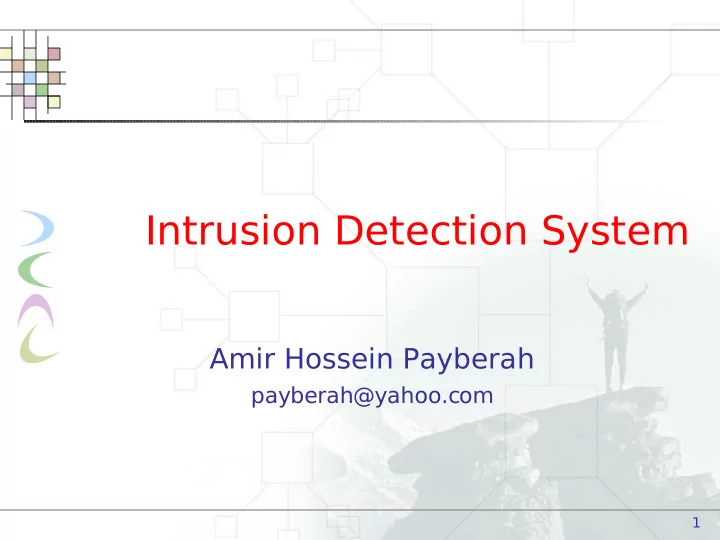

Intrusion Detection System Amir Hossein Payberah payberah@yahoo.com 1
Contents Intrusion Detection Systems Tripwire Snort 2
IDS (Definition) Intrusion Detection is the process of monitoring the events occurring in a computer system or network, analyzing them for signs of security problem. The bulk of intrusion detection research and development has occurred since 1980. 3
IDS (Architecture) 4
IDS (Information Sources) The first requirement for intrusion detection is a set of input data. Which source is the best source for intrusion detection? 5
Information Sources (Cont.) Host-Based Information Sources Network-Based Information Sources 6
Host-Based Operating System Audit Trails System Logs Application Information Target-Based Monitoring 7
Network-Based In network-based approach, information is collected form the network traffic stream as it travels on the network segment. 8
IDS (Analysis) Analysis is organizing and characterizing data about user and system to identify activity of interest. This process is divided into three phases: Constructing the analyzer. Performing analysis of live data. Feedback or refinement of the process. 9
Analysis (Cont.) Misuse Detection Engines look for something defined to be bad. Anomaly Detection Engines look for something rare or unusual. 10
IDS (Responses) Active Responses Take action against the intruder Amend the environment Collect more information Passive Responses Alarm and notification SNMP Trap 11
Contents Intrusion Detection Systems Tripwire Snort 12
Tripwire It is a host-based IDS. It is one of the most popular applications for determining when a file or directory has been alerted. It scans the system’s hard drive and create a database. 13
Tripwire Files /usr/sbin/tripwire The tripwire binary responsible for reading, creating and updating the database. /etc/tripwire/twpol.txt The tripwire policy configuration file. /etc/tw.pol The signed tripwire policy file. 14
Tripwire Files /usr/tripwire/twinstall.sh The file that signs the /etc/tripwire/twpol.txt and /etc/tripwire/twcfg.txt files. /etc/tripwire/twcfg.txt Configures the environment for the /usr/sbin/tripwire binary. /var/lib/tripwire/hostname.twd The default location of the Tripwire database file. 15
Configuring the Tripwire Policy File /etc/tripwire/twpol.txt /etc/shadow -> $(IgnoreNone); Any file followed by the IgnoreNone argument will be checked by Tripwire’s “paranoid mode,” which means that any and all changes will be reported to you. !/proc; Informs Tripwire to ignore the /proc directory. 16
Creating the Tripwire Policy File After you have installed Tripwire and edited the /etc/tripwire/twpol.txt, you are ready to begin the initial scan. Simply run the /etc/tripwire/twinstall.sh script. It will then create the Tripwire configuration file. 17
Database Initialization Mode After you have created a policy file, you can then enter database initialization mode. tripwire --init tripwire --help init 18
Integrity Checking Mode After you have created the database, you can run Tripwire in integrity checking mode. tripwire --check 19
Contents Intrusion Detection Systems Tripwire Snort 20
Snort It is a network-based IDS. It places the NIC into promiscuous mode and captures all traffic on your network segment. 21
Snort Files and Directories /usr/local/snort The Snort binary, when installed from an RPM package. /usr/local/bin/snort The binary, when installed from a tarball. /etc/snort/ A directory that contains the Snort configuration file, as well as all Snort rules. 22
Snort Files and Directories /etc/snort/snort.conf The Snort configuration file. /usr/share/doc/snort-1.7 The documentation directory if you install Snort using the RPM. If you install using a tarball, the documentation will be in the subdirectory where you installed all of the source files. /etc/rc.d/init.d/snortd The initialization script for snortd. 23
Starting Snort Start Snort as a simple packet sniffer. This command will log traffic only at the network level. snort -v 24
Starting Snort 25
Starting Snort If you use the -d option to have Snort capture application-layer data, you will capture additional information. snort -vd 26
Starting Snort 27
Logging Snort Entries /usr/sbin/snort -u snort -g snort -dev -l /var/log/snort -h 192.168.2.0/24 This command starts Snort under a user and group of Snort. It then logs all packets to the /var/log/snort directory. The e option has Snort read data link layer headers, as well. The –h command tells Snort that the 192.168.2.0/24 network is the home network and to log all packets relative to the 192.168.2.0 system. 28
Running Snort as a Network-Based IDS snort -u snort -g snort -dev -h 192.168.2.0/24 -d -D -i eth0 -c /etc/snort/snort.conf This command has snort run in daemon mode (-D) and specifies the eth0 interface. The last part of the command specifies the snort.conf file, which if properly configured will enable Snort to log traffic only as it violates the rules it contains. 29
Question? 30
Recommend
More recommend